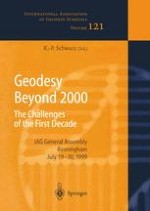2000 | OriginalPaper | Chapter
Calibration/validation methods for GRACE
Author : Christopher Jekeli
Published in: Geodesy Beyond 2000
Publisher: Springer Berlin Heidelberg
Included in: Professional Book Archive
Activate our intelligent search to find suitable subject content or patents.
Select sections of text to find matching patents with Artificial Intelligence. powered by
Select sections of text to find additional relevant content using AI-assisted search. powered by
The upcoming GRACE (Gravity Recovery and Climate Experiment) satellite mission is expected to map Earth’s global gravitational field with unprecedented accuracy, especially at the long wavelengths. The measurements are line-of-sight range rates between two co-orbiting, low-altitude satellites that can be transformed into differences of geopotential and horizontal gravitation. One method to attempt the calibration and validation of GRACE data is to compare these in situ measurements using very accurate local terrestrial gravity fields that are upward continued to satellite altitude. This paper presents a rudimentary analysis of the requirements in gravity anomaly data spacing, accuracy, and extent to compute differences in disturbing potential and horizontal gravity disturbance at GRACE altitude. These studies show that to achieve the anticipated in situ accuracy of 0.01 m2/s2 in potential and 0.01 mgal in gravitation the terrestrial spacing and accuracy requirements are rather loose, e.g., 0.5° spacing and 0.25 mgal accuracy. Data extent, on the other hand, is much more important, where caps with radius larger than 10° are required, and then only to validate wavelengths smaller than 1200 km (30-deg reference field). Furthermore, it is shown that terrestrial data requirements are significantly less stringent in the case of computing horizontal gravitation differences at altitude rather than potential differences
